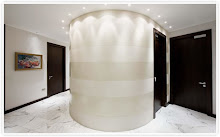While many companies may brand their product under a term such as Marmorino or Venetian Polished Plaster the products can differ in terms of texture, appearance, ingredients and cost.
Texture/Appearance
Venetian Plaster normally refers to a smooth shiny polished surface, however depending on the manufacturer it could refer to a wide range of plaster products, not just from Italy. Many manufacturers use the term to add value to their cheaper products.
Marmorino, while refers to a smooth, shiny polished plaster can further be categorised depending on it texture, grain size or shine. For example Stucco Italiano provides Classic Marmorino which has the smallest grain size and therefore provides the smoothest surface with the highest shine. Stucco Italiano's Carrara Marmorino has a slightly coarser grain size giving a slightly rougher texture with a more matt shine. There is also a coarser grain Carrara Marmorino available from Stucco Italiano as a special request for the more experienced artisan. Stucco Italiano also provides Marmorino flooringwhich is a stronger version which has a more matt shine; however unlike the others which are all lime based Stucco Italiano flooring Marmorino has cement content.
Ingredients
Some Marmorino or Polished plaster products may be made from Lime-based ingredients, others could be cement based or acrylic.
Lime-based Polished Plasters
Generally lime based polished plaster is supplied as a pre-mixed wet material and contains a minimum of 40% marble powders with no more than 2% binders. This is recognised within restoration projects as a suitable quality material. The end result should be smooth and cold to the touch without reliance on wax or machines to make it shiny. Waxing is an option but if this product is installed by a talented craftsperson there should be adequate shine in the polished plaster with waxing only being used for protection.
Cement based polished plasters
Polished plasters with cement content are supplied as a dry mix, thus making them less shiny and cheaper than lime-based polished plasters. Normally wax is needed to achieve a high shine. The disadvantage of the high shine due to waxing means the shine will dull over a period of time and result in it having to be rewaxed to maintain the high shine.
Acrylic Polished Plasters
The appearance of acrylic polished plasters tends not to be as rich as the original lime-based polished plasters. They would not be cold to the touch.
An important point to remember is you should always request a sample and technical information to ensure you know which Polished Plaster you are getting.
Subscribe to:
Post Comments (Atom)





No comments:
Post a Comment